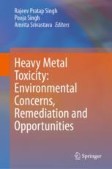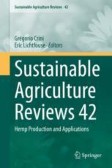Search
Search Results
-
Application Effect of Straw Returning and Biochar in the Improvement of Saline-Alkali Land in Northeast China
AbstractWith the gradual change of climate, the organic matter and nutrients in the soil are constantly losing. It induces the creation of saltwater...

-
Application of Rice (Oryza Sativa) Husk as a Sorption Material for the Removal of Pollutants from Aqueous Media (A Review)
AbstractThe applications of rice husk (waste from Oryza sativa production) as a sorption material for the removal of pollutants of various classes,...
-
Process Integration via a Sustainable Biorefinery Approach Using Agro-industrial Residues and Photosynthetic Consortia
Integration of processes is proposed in this chapter to describe the production of bioenergy and value-added co-products via a biorefinery approach....
-
Microbial Remediation of Heavy Metals
Heavy metals presence in wastewater are usually associated with the usage of metal-based chemical substances such as inorganic coagulant, metal salt,...
-
Investigation of sound absorption capability of pine (Pinus densiflora) cone particles
In this study, the sound absorption capability of pine ( Pinus densiflora ) cone particles was investigated as an alternative and eco-friendly,...

-
Contemporary Approaches for Biochar Production from Agro-Waste and Its Current and Prognostic Applications in Environment Health
Biochar is produced from the lignocellulosic biomass by pyrolyzing at the temperature range of 550–850 K. Usually, wood residues and agricultural...
-
Hydrocarbon selectivity enhancement through catalytic fast co-pyrolysis of almond shell and plastic blends
BackgroundThe aim of this article is to explore possible pathways for the synergistic optimization of bio-oil by the catalytic fast co-pyrolysis of...

-
Biochar is colonized by select arbuscular mycorrhizal fungi in agricultural soils
Arbuscular mycorrhizal fungi (AMF) colonize biochar in soils, yet the processes governing their colonization and growth in biochar are not well...

-
Effect of the pretreatment on the porosity of the hybrid activated carbons prepared from wood-based solid and liquid precursors
The purpose of this work is to study the relationship between carbonization temperatures (400 and 500 °C) of biomass-based precursors and porosity of...

-
NTFP and Homegarden vis-à-vis Land Degradation Neutrality: Sustainable Livelihood and Development
Livelihoods and sustainability—both have their importance. In the general interest, the long-term potential for supporting livelihoods must be...
-
Tropical mobola plum (Parinari Curatellifolia): a full characterization of wood and bark within the scope of biorefineries
Parinari curatellifolia is the main species used to produce charcoal in Angola. Its chemical, anatomical, and thermal properties were analyzed. The...

-
Energy Production Features of Miscanthus Pellets Blended with Pine Sawdust
The primary objective of this study was to evaluate the qualities of Miscanthus pellets blended with pine sawdust at various ratios ( Miscanthus /pine...

-
Hemp Fibers for Wastewater Treatment
Sorption by low-cost lignocellulosic materials is the method receiving the utmost attention in searching for the best green approach in water...
-
Forest Management by Local Communities: Evolution and Current Trends Since the 1970s
Communities can be good stewards of forest lands as well as providers of forest products and environmental services. For many years most develo**...
-
Facile and low-cost heteroatom-doped activated biocarbons derived from fir bark for electrochemical capacitors
Chinese fir bark was selected as a precursor, and a chemical activation method was used to prepare high surface area activated biocarbon materials...

-
Efficient methane production from agro-industrial residues using anaerobic fungal-rich consortia
Anaerobic digestion (AD) emerges as a pivotal technique in climate change mitigation, transforming organic materials into biogas, a renewable energy...

-
The significance of structural components of lignocellulosic biomass on volatile organic compounds presence on biochar - a review
The product of thermochemical processing of lignocellulosic biomass is biochar. It has a range of properties that make it suitable for a variety of...

-
Facilitation of working memory capacity by transcranial direct current stimulation: a secondary analysis from the augmenting cognitive training in older adults (ACT) study
Aging is a public health concern with an ever-increasing magnitude worldwide. An array of neuroscience-based approaches like transcranial direct...

-
Biomass: Resources and Sustainable Utilization
Biomass is a renewable organic material derived from living organisms such as plants, animals, microorganisms, and algae including food and...
-
Recent Advances in Biological Wastewater Treatment
Water is a universal solvent and liquid required in most anthropogenic, natural, and biochemical processes. Once used, water will have chemical or...
